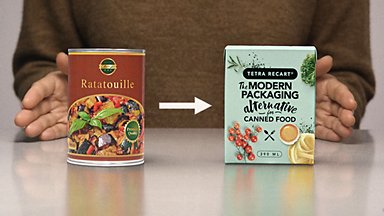6 ways Tetra Recart® can help you optimise your operations
An innovative packaging solution for shelf-stable foods, Tetra Recart® is designed to serve the evolving needs of consumers, retailers and producers. But besides looking good and keeping food safe, the value added by Tetra Recart goes far beyond the packaging itself. We sat down with Gustaf von Friesendorff, Competitive Insights Leader at Tetra Pak® to discuss some of the ways these future-proof packages can help optimise operations for food producers.
1. Connect to a global co-packing network
When you choose Tetra Recart as your packaging solution, you get access to our extensive global network of co-packers which can give you a shortcut to expanding your product portfolio and reaching new markets.
“If you are a brand owner and are interested in Tetra Recart but are not ready to invest in new greenfield site, or if you want to be the first mover in the market, we have a network that can help you produce the volumes you need. And our network is growing year by year,” explains Gustaf.
2. Convenience of a one-stop shop
Keep things simple and convenient by partnering with one supplier for providing processing equipment, packaging equipment and the packaging itself. With us as your sole supplier, there will be no crossed wires when it comes to supplies, equipment compatibility and service. You’ll also be entering into a valuable and rewarding relationship with established global experts on food processing and packaging.
3. Greater efficiency with automation
A highly automated Tetra Recart line can save you space and money. It requires fewer operators and less equipment than a line for metal cans or glass jars. Pre-formed packaging such as cans and jars requires more space and entails more parts like separate lids and labels. This also increases the number of processes and in turn, workers on the line. In comparison, an automated Tetra Recart line is streamlined and efficient.
Gustaf says: “When we look at operational costs, one thing that is consistently increasing over time is labour costs. Sometimes producers simply don’t realise that by increasing automation, they can reduce the amount of people working on a line and consolidate the supervision of that line. Automation is one of the most effective tools producers can use to control costs.”
The Tetra Pak R1 and Tetra Pak R2 filling machines for Tetra Recart both feature a high level of automation.
4. Flexibility in package size
The ability to produce products in a wide range of package sizes to react to needs and opportunities in the market is a big advantage of having a Tetra Recart line. It removes the limitations of traditional can and jar lines that might prevent your future growth. It also safeguards you from having to make future investments in new lines when the need for producing different product sizes arises.
5. Tetra Recart is cost competitive
When compared to metal cans and glass jars, Tetra Recart is clearly the cost-effective packaging choice. These formats, especially cans, are already expensive and have become increasingly more so because of recent disruptions such as regional conflicts, as well as lockdowns due to the global pandemic.
“These disruptions have affected regions which produce raw materials for glass jar and metal can manufacturing,” says Gustaf. “On the other hand, the price of materials such as carton board, which makes up the bulk of Tetra Recart cartons, has not increased to the same extent.”
6. It’s more efficient to store
Since it’s packed flat and isn’t pre-formed, the amount of empty Tetra Recart packaging that can be stored is 6-10 times that of jars and cans per pallet-load. That means you can store 600% to 1,000% more packaging in the same amount of storage space. This translates to a much smaller footprint on your factory floor and less frequent packaging shipments.
Once filled, Tetra Recart’s rectangular shape means that each pallet can hold on average 10-20% more of your product, for further logistical efficiency.
Partner with an established network and one-stop-shop for all your needs. Save on materials, manpower, storage and future investments, while gaining the flexibility to produce a wide range of sizes. Sound good? Get in touch to discuss how we can help optimise your operations!



